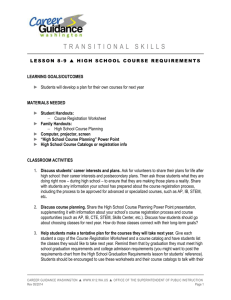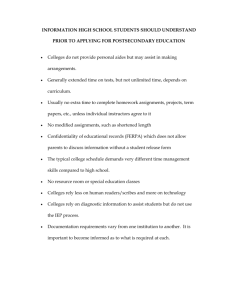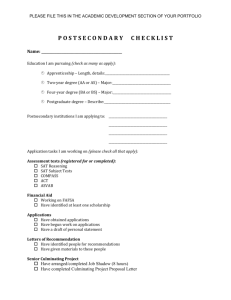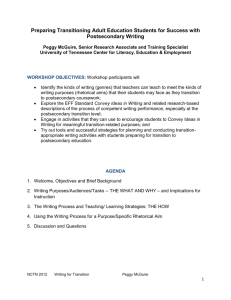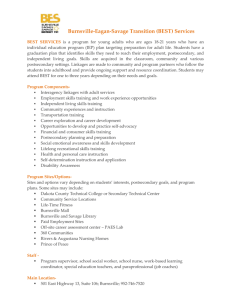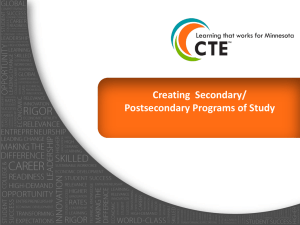Career Guidance WA Gr 11-12 HS & PS Course Planning
advertisement
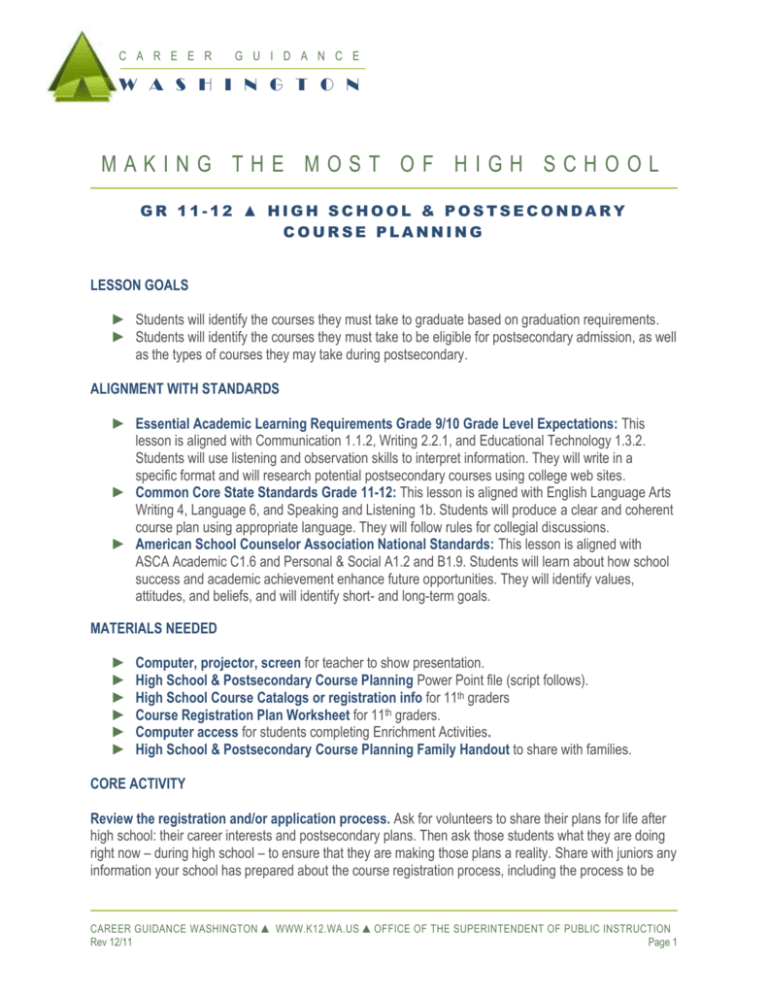
C A R E E R G U I D A N C E W A S H I N G T O N MAKING THE MOST OF HIGH SCHOOL GR 11-12 ▲ HIGH SCHOOL & POSTSECONDARY COURSE PLANNING LESSON GOALS ► Students will identify the courses they must take to graduate based on graduation requirements. ► Students will identify the courses they must take to be eligible for postsecondary admission, as well as the types of courses they may take during postsecondary. ALIGNMENT WITH STANDARDS ► Essential Academic Learning Requirements Grade 9/10 Grade Level Expectations: This lesson is aligned with Communication 1.1.2, Writing 2.2.1, and Educational Technology 1.3.2. Students will use listening and observation skills to interpret information. They will write in a specific format and will research potential postsecondary courses using college web sites. ► Common Core State Standards Grade 11-12: This lesson is aligned with English Language Arts Writing 4, Language 6, and Speaking and Listening 1b. Students will produce a clear and coherent course plan using appropriate language. They will follow rules for collegial discussions. ► American School Counselor Association National Standards: This lesson is aligned with ASCA Academic C1.6 and Personal & Social A1.2 and B1.9. Students will learn about how school success and academic achievement enhance future opportunities. They will identify values, attitudes, and beliefs, and will identify short- and long-term goals. MATERIALS NEEDED ► ► ► ► ► ► Computer, projector, screen for teacher to show presentation. High School & Postsecondary Course Planning Power Point file (script follows). High School Course Catalogs or registration info for 11th graders Course Registration Plan Worksheet for 11th graders. Computer access for students completing Enrichment Activities. High School & Postsecondary Course Planning Family Handout to share with families. CORE ACTIVITY Review the registration and/or application process. Ask for volunteers to share their plans for life after high school: their career interests and postsecondary plans. Then ask those students what they are doing right now – during high school – to ensure that they are making those plans a reality. Share with juniors any information your school has prepared about the course registration process, including the process to be CAREER GUIDANCE WASHINGTON ▲ WWW.K12.WA.US ▲OFFICE OF THE SUPERINTENDENT OF PUBLIC INSTRUCTION Rev 12/11 Page 1 GRADE 11-12 ▲ HIGH SCHOOL & POSTSECONDARY COURSE PLANNING approved for advanced or specialized courses, such as AP, IB, STEM, etc. For seniors, quickly review any resources your school offers to help them with the postsecondary application process. (2 minutes) Discuss course planning. Share the High School & Postsecondary Course Planning Power Point presentation, supplementing it with information about your school’s course registration process and course opportunities (such as AP, IB, CTE, STEM, Skills Center, etc.). For juniors, discuss how students should go about choosing classes for next year. For seniors, discuss how they will use the same process to select a major and choose courses to take during postsecondary. (10-15 minutes) ENRICHMENT ACTIVITIES For juniors: Help students make a tentative plan for the courses they will take next year. Give each student a copy of the Course Registration Plan Worksheet and a course catalog and have students list the classes they would like to take next year. Remind them that by graduation they must meet high school graduation requirements and college admission requirements (you might want to post the requirements chart from the High School Graduation Requirements lesson). Students should be encouraged to use these worksheets and their course catalogs to talk with their families about next year. In addition, these worksheets can help high school counselors if they are able to meet with students. (15-20 minutes) For seniors: Research course opportunities at a college of interest. By now, most seniors should have identified postsecondary programs and should have either applied or be planning to apply to them. Ask each senior to select one of their postsecondary choices and go to the web site of that college. Then ask them to research the types of courses they might take next year. Most colleges will have a course catalog posted, or will have departmental pages that provide lists of required courses. Have students note course ideas and ask for several volunteers to share a potential course plan for next year. (Note that many students will attend college orientation and course registration sessions during spring of senior year or during the summer immediately after graduation. Familiarizing themselves now with their college’s requirements and course offerings will help them make the most of these orientation events.) For seniors: Help students learn about apprenticeship opportunities. Explain that an apprenticeship is an opportunity to earn money while working to learn a skilled trade. There are apprenticeship programs for many different career areas. Help students search for apprenticeship opportunities at the Washington State Department of Labor & Industries’ “How to Become and Apprentice” web page: www.lni.wa.gov/TradesLicensing/Apprenticeship/Become/default.asp. Ask each student to identify one possible apprenticeship program. EXPLORATION OPPORTUNITIES Provide course counseling and/or postsecondary advising. If possible, have a school counselor meet with your students and explain the course options or postsecondary opportunities they will have for next year, and the process they need to complete. If possible, offer individual meetings to help each student plan his or her year. CAREER GUIDANCE WASHINGTON ▲ WWW.K12.WA.US ▲OFFICE OF THE SUPERINTENDENT OF PUBLIC INSTRUCTION Rev 12/11 Page 2 GRADE 11-12 ▲ HIGH SCHOOL & POSTSECONDARY COURSE PLANNING Organize a CTE/Apprenticeship Night for students and their families. If you wish, you might want to help students and their families learn more about CTE opportunities and post-high school apprenticeships by holding a CTE/Apprenticeship Night, during which representatives from local apprenticeship programs and community and technical colleges, as well as teachers of CTE courses at your high school or local Skills Center can share information about course and program opportunities. This evening could be organized during Student-led Conference time. The programs could be set up in the main hallway of the school or in a place where families will turn in data sheets and go for refreshments. Organize a Registration Fair for students and their families. Alternatively, you could organize a more broad-based Registration Fair with information about all course offerings available for next year. This could be an opportunity for students and their families to meet with teachers and to learn about opportunities such as AP, IB, honors, CTE, Running Start, Tech Prep, STEM, etc. Note that this lesson plan is one of three designed to help 11th and 12th grade students prepare for next year’s course registration (or, for seniors, to ensure they are on track to graduate on time, have completed all graduation requirements, such as the High School & Beyond Plan and Culminating Project, and are prepared to be strategic in postsecondary). The lessons in this series cover: 1. High school graduation requirements 2. High school & postsecondary course planning 3. High School & Beyond Plan If possible, teach all three lessons and then organize a session to share this information with families. WASHINGTON STATE RESOURCES ► OSPI Graduation Toolkit: www.k12.wa.us/GraduationRequirements/GraduationToolkit.aspx Information for students, families, and teachers about high school graduation requirements. ► State Board of Education: www.sbe.wa.gov Minimum high school graduation requirements for Washington State ► Higher Education Coordinating Board: www.hecb.wa.gov Minimum college admission requirements: www.hecb.wa.gov/sites/default/files/RevisedMCASOverviewParents-April2011_1.pdf ► OSPI CTE: www.k12.wa.us/careerteched/ Information about CTE (Career & Technical Education) and resources available around the state. ► Running Start: http://sbctc.edu/college/s_runningstart.aspx Information about the Running Start program at community colleges CAREER GUIDANCE WASHINGTON ▲ WWW.K12.WA.US ▲OFFICE OF THE SUPERINTENDENT OF PUBLIC INSTRUCTION Rev 12/11 Page 3 C A R E E R G U I D A N C E W A S H I N G T O N HIGH SCHOOL & POSTSECONDARY COURSE PLANNING POWER POINT SCRIPT This presentation can be used by a school counselor or teacher to help students in 11th grade prepare for course registration for next year, and for 12th grade students to reflect on the courses they have taken during high school and prepare for their first year of postsecondary education. Students in high school have a great deal of choices and many opportunities, and this presentation is designed to review some of those opportunities and to get them thinking about the connection between their courses and their plans for life after graduation. This presentation is based on statewide information – it can and should be supplemented with information that is specific to your school district. In particular, you may wish to include information about your school’s registration process, as well as any programs that are unique to your school. Now that your students are nearly finished with high school, the courses they are taking are extremely important, both in helping them graduate from high school and in setting them on their course toward college and career. Because your students’ choice of courses will determine whether they are qualified for postsecondary programs, it’s important for them to realize that getting into a postsecondary program – 4-year college, 2-year community college, trade or technical school, or an apprenticeship program – will likely have admission requirements that they need to research and then make plans to meet. Studies have shown that students do better academically and are less likely to drop out if they have a goal. Now is a good time for students to set goals about their career path. One way to start that process is to choose a career cluster that sounds interesting. Once they identify a career cluster that sounds interesting, students should research different careers. They should learn about the postsecondary education needed for different careers and then use that information to plan what classes they should take during high school. You might want to introduce Washington State’s Career Bridge: www.careerbridge.wa.gov/. Students can learn about different careers there. They might also be able to conduct career interviews or participate in job shadows or internships. To keep their options open, students should also be encouraged to take the most advanced courses possible during high school. CAREER GUIDANCE WASHINGTON ▲ WWW.K12.WA.US ▲OFFICE OF THE SUPERINTENDENT OF PUBLIC INSTRUCTION Rev 12/11 Page 4 HIGH SCHOOL COURSE PLANNING POWER POINT SCRIPT, Continued As students explore different career possibilities, they will also need to research what type of postsecondary education they will need. They should know that very few jobs are open to people with only a high school diploma. But they should also learn that there are many different options after high school – from an apprenticeship that will give them hands-on training while they learn, all the way to a postgraduate degree, such as an MD. In many cases, students can follow “career ladders” and get additional training as they move up the ladder. Remind juniors of the process your school uses for course registration. Make sure they have created a four-year plan that outlines the courses they hope to take during senior year, and let them know how they can get help to update that plan. As they think about the courses they plan to take, students will learn more about the requirements they must meet… and why they should do more than the minimum to succeed. For seniors, have them review their coursework and make plans for the major they will pursue during postsecondary. NOTE that this slide should be supplemented with information about your school district’s high school requirements. Students in high school need to think about several types of credit requirements: • First are the state’s high school graduation requirements. These are the MINIMUM number of course credits needed to graduate from high school. This slide lists the statewide requirements. • Next are your district’s graduation requirements. Many school districts impose more rigorous minimum requirements than the state’s. • Next are the College Academic Distribution Requirements (CADRs) or the minimum course credits students need to be eligible for admission to a Washington State college or university. These CADRs are also minimums – many colleges require more. • The final column shows the recommended courses students should take if they wish to apply to a selective college. These colleges require significantly more credits. CAREER GUIDANCE WASHINGTON ▲ WWW.K12.WA.US ▲OFFICE OF THE SUPERINTENDENT OF PUBLIC INSTRUCTION Rev 12/11 Page 5 HIGH SCHOOL COURSE PLANNING POWER POINT SCRIPT, Continued Remind students that their last two years in high school are extremely important as they prepare for life after high school. They should take the most rigorous courses they can, including: • Advanced courses, such as honors courses, International Baccalaureate (IB) programs or Advanced Placement (AP) opportunities • Career & Technical Education (CTE) courses and programs, that may include Skills Center courses, pre-apprenticeships, and other hands-on learning opportunities • Dual credit courses (such as Tech Prep, AP, and Running Start) that give students the opportunity to earn college credit while in high school Please feel free to customize the next group of slides or add slides with information specific to your school’s programs. These next slides will be less relevant for seniors, but may help them recap their accomplishments. Advanced courses, often called “gatekeeper” courses, are a key determinant of students’ success in postsecondary. That means taking as many years of math and science as possible, and being aware of the prerequisites for higher-level math and science courses. Students should also know whether your high school offers honors courses and what they must do to apply for honors. Honors courses typically cover more material and more advanced material so that students can more quickly move on to advanced courses. In addition, students (and their families) should know about any special programs your school offers, as many of these programs may require prerequisites. Special programs may include International Baccalaureate or Advanced Placement courses. Career & Technical Education programs serve students throughout Washington State by giving them industry-recognized training, 21st century skills, and the knowledge to succeed in college or career. CTE helps students explore career opportunities while they are still in school, focusing in particular on high-demand, high-wage occupations in health sciences, science, technology, engineering and math, and construction. CTE can provide students with options that link middle school to high school and to postsecondary opportunities, blend academic and technical studies, and connect students to their goals for the future. CAREER GUIDANCE WASHINGTON ▲ WWW.K12.WA.US ▲OFFICE OF THE SUPERINTENDENT OF PUBLIC INSTRUCTION Rev 12/11 Page 6 HIGH SCHOOL COURSE PLANNING POWER POINT SCRIPT, Continued Skills Centers are an integral part of CTE programming in Washington. They function as an extension of the high schools within a local region by providing high school students with job preparation skills. The primary purpose of Skills Centers is to give students the academic and work skills to successfully enter the job market or advanced education and training. Washington State currently has 13 Skills Centers. The existing Skills Centers serve 7,000 students in 85 districts. Students in those districts typically attend their home high school for half of each day and attend the skills center for the other half of the day. Skills Center programs vary by region but include a wide range of fields, including (but not limited to) computer programming, firefighting, audio production, culinary arts, health care, construction, and marketing. Some Skills Centers also offer AP programs. Thanks to Legislative funding, STEM opportunities in Washington State are available for students in grades 7-12. It’s important for students to understand that a STEM education will provide them with the abilities to USE strong foundations in science, technology, engineering, and math to solve real world problems. Help students learn about the STEM opportunities in your district. Dual credit programs give students the opportunity to earn high school and college credit simultaneously. In some cases, students earn college credit automatically for completing a course; in other cases, students must score above a certain level on an exam to earn college credit. (Note that the transferability of college credit will depend on the student’s ultimate postsecondary choice.) Dual credit programs are valuable as they help build confidence and competence while reducing costs, as students do not need to pay college tuition. Some dual credit programs are courses offered within the high school; others require students to travel to a local community college. Some dual credit programs also function as Career & Technical Education, helping students prepare for an apprenticeship or career opportunity. Advanced Placement (AP) classes are typically available to students in grades 10-12. Students who complete those classes and then take a College Board-sponsored AP exam in that subject can earn college credit if their scores are high enough. (Note that the transferability of college credit is up to the student’s postsecondary institution.) AP courses are offered in nearly every subject area, from World History to English to Biology. The courses available to students will depend on your high school’s offerings. A number of existing AP courses fit well with CTE programs. Both AP and CTE focus on relevance and rigor, and their intertwining will mean more student success after high school. With CTE career fields and AP education, students receive training for work and for life. CTE/AP pairings include courses such as AP Computer Science, AP Studio Art Drawing 2D/3D, AP Environmental Science, AP Psychology, and AP Macroeconomics. CAREER GUIDANCE WASHINGTON ▲ WWW.K12.WA.US ▲OFFICE OF THE SUPERINTENDENT OF PUBLIC INSTRUCTION Rev 12/11 Page 7 HIGH SCHOOL COURSE PLANNING POWER POINT SCRIPT, Continued Tech Prep awards high school students dual credit for career and technical education (CTE) courses articulated to college programs. Tech Prep dates back to the early 1980s, when business shifted from the industrial age to the age of technology. High schools began refocusing their programs to include more technical training, applied academics and opportunities mentoring and internships in the workplace. Washington State’s Tech Prep is well respected and comprehensive. All of the state’s 34 community and technical colleges are partners to Tech Prep, with more than 300 public high schools in 204 districts participating. Tech Prep students earn an average of 6 college credits. Where a student lives will determine what programs are available through Tech Prep. Tech Prep courses are offered in a variety of fields that include horticulture, environmental science, automotive technology, digital communications, accounting, business, graphic design, and health sciences. Washington State’s Running Start program offers qualified high school students to chance to take college-level courses at low cost at a local community college campus. Running Start gives students the opportunity to take courses in nearly any subject area to help them prepare for college or a career. Students who are interested should talk with their high school counselor. Students should realize that the work they do today is preparing them for the future. They should use the remainder of their time in high school to prepare for postsecondary – particularly by taking advanced, CTE, and dual credit courses. In addition, students should be encouraged to get involved in extracurricular activities so that they will be engaged with the school community. Conclude the lesson by helping juniors draft an outline of the courses they hope to take next year. This plan should be a part of their comprehensive four-year plan. Help seniors research the types of courses they may take next year in college. CAREER GUIDANCE WASHINGTON ▲ WWW.K12.WA.US ▲OFFICE OF THE SUPERINTENDENT OF PUBLIC INSTRUCTION Rev 12/11 Page 8 C A R E E R G U I D A N C E W A S H I N G T O N MAKING THE MOST OF HIGH SCHOOL COURSE REGISTRATION PLAN WORKSHEET (GR 11) Name: _________________________________ Grade Level Next Year: Think about your plans for postsecondary education, focusing on the number of credits you need to graduate from high school and be admitted to your top choice postsecondary program. What courses should you take during senior year? Use your school’s course catalog, as well as the information you’ve been given about course opportunities to list the courses you might consider. This will help you prepare for course registration. SUBJECT AREA SEMESTER 1 SEMESTER 2 ENGLISH MATHEMATICS SCIENCE WORLD LANGUAGE SOCIAL STUDIES CTE (Occupational) ARTS HEALTH/PE OTHER ELECTIVES My priorities for senior year are My plan for postsecondary is: To prepare for postsecondary, I have: Researched postsecondary programs Visited colleges Taken entrance exams CAREER GUIDANCE WASHINGTON ▲ WWW.K12.WA.US ▲OFFICE OF THE SUPERINTENDENT OF PUBLIC INSTRUCTION Rev 12/11 Page 9 C A R E E R G U I D A N C E W A S H I N G T O N MAKDING THE MOST OF HIGH SCHOOL HIGH SCHOOL & POSTSECONDARY COURSE PLANNING FAMILY HANDOUT WHAT COURSES SHOULD YOUR STUDENT TAKE IN HIGH SCHOOL? High school students need to choose courses that will help them meet high school graduation requirements and prepare for postsecondary programs and career opportunities. Students should also choose courses that let them make the most of the opportunities that are available at their school. START BY IDENTIFYING A POSSIBLE CAREER A good way to start is by having your student identify several careers that sound interesting. Students can then research these careers to learn what postsecondary education they need and what classes they should take in high school to prepare. Your students’ school counselor can help with this research. LEARN ABOUT HIGH SCHOOL OPPORTUNITIES Students who take rigorous and demanding courses in high school do better in postsecondary. Help your student learn about opportunities for rigorous courses at your high school: ► Advanced courses, such as honors courses, International Baccalaureate (IB) programs or Advanced Placement (AP). ► Career & Technical Education (CTE) courses and programs that may include courses at a Skills Center, a pre-apprenticeship, or other hands-on learning opportunities. ► Dual credit courses (such as Tech Prep, AP, and Running Start) that give students the opportunity to earn college credit while in high school. LEARN ABOUT POSTSECONDARY OPPORTUNITIES As students near the end of high school, it is time to think about what they will do after graduation. Because most postsecondary programs require students to apply during their senior year in high school, now is a good time for students to research postsecondary programs and to think about what they would like to study and what courses they would like to take. Resources to help students research postsecondary programs include: ► Apprenticeships: Learn about apprenticeship programs from the Washington State Department of Labor & Industries: www.lni.wa.gov/TradesLicensing/Apprenticeship/Become/default.asp. ► Community & Technical Colleges: Visit www.CheckOutACollege.com to learn about Washington State’s community and technical colleges for certificate programs and Associate’s degrees. ► Four-year public colleges: Visit the Higher Education Coordinating Board for links to Washington’s six public four-year colleges: www.hecb.wa.gov/links/colleges/collegesindex.asp. CAREER GUIDANCE WASHINGTON ▲ WWW.K12.WA.US ▲OFFICE OF THE SUPERINTENDENT OF PUBLIC INSTRUCTION Rev 12/11 Page 10
